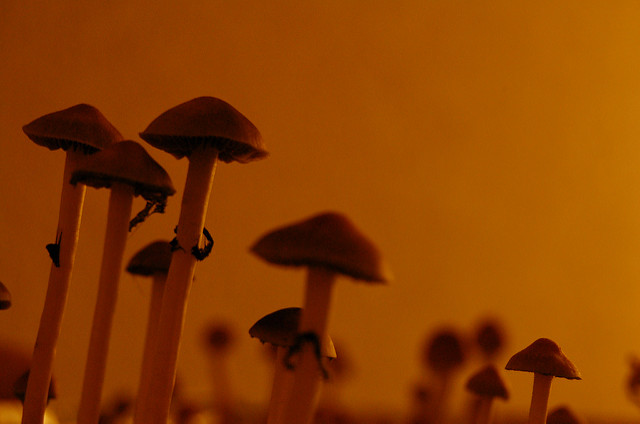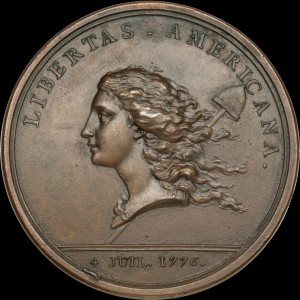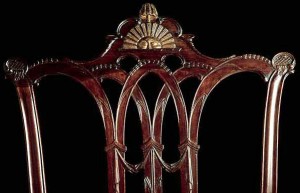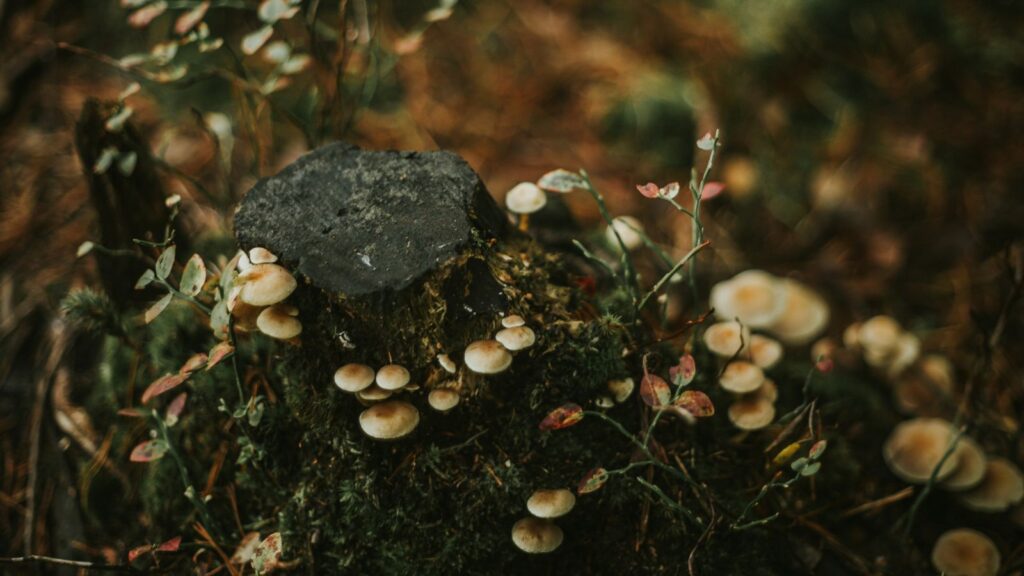Living in the Deep South where they grow wild in virtually every grain-fed cattle field, my brother and I first began foraging Psilocybe cubensis mushrooms in our early teens. Once while hunting for mushrooms in a field next to our paternal grandmother’s home in Senatobia, Mississippi, we were mortified to discover that our rather square and straight-shooting uncle had been watching us from the house as we picked. My brother and I quickly ditched the harvested specimens and walked reluctantly to where our uncle stood waiting. To our surprise, he wasn’t reprimanding in the least. Rather, he was grinning widely as he chided us: “Boys, you two are jus’ like ya great-great grandaddy Daugherty; ya grandmama’s grandaddy. You’d catch him er’ morn at the crack of dawn, walkin’ them there cow fields, lookin’ for mushrooms and herbs. He was a healer, ya know?” “A healer!?” I exclaimed inquisitively. “That’s right” he answered. “He trained with a Native American; Chickasaw or Choctaw. I can’t recall which. You’ll have to ask ya grandmama.”
Of course, I have no way of knowing if the mushrooms that my great-great Grandfather Daugherty was allegedly harvesting were actually P. cubensis. Nor do I know if the Choctaw or Chickasaw tribes even possess(ed) a knowledge of the visionary properties of coprophilic psilocybin mushrooms. I recount this anecdote only as a means of raising the question of whether or not psilocybin mushrooms could have been known to certain esoteric circles in North America prior to the publication of the Wassons’ article in Life Magazine in May of 1957.
Ethan Allen Hitchcock, who died in Georgia in August of 1870, was a career United States Army officer that served as a major general during the American Civil War. He was also an avid student of and commentator upon alchemy. A note discovered in the back flyleaf of a copy of Hitchcock’s classic study Remarks Upon Alchemy (1857) reads:
“The Secret of our Stone…shall shew itself forth as though it bloomed sweetly upon the dunghill. And if you shall ask me what it resembles – I shall say to you that it lives and is to be found in the likeness and form of many things in Nature. For it can be as the Moon as has been said – If they say the Moon is blue, we must believe that it is true. – But this only if molested, for the colour of the Moon is white in its naturalistic State.”
What other than the Psilocybe cubensis mushroom [1] meets the criteria of being at once a living thing in nature that, in addition to ‘blooming’ upon dung, also appears as the moon, i.e. round and pale, unless the same has been “molested,” in which case it then turns blue?
Psilocybe cubensis is a coprophilic mushroom meaning that it can only subsist upon the dung of certain species. Its psychoactive constituents are a pair of powerful compounds termed psilocin and psilocybin, first synthesized by Swiss chemist Albert Hofmann and brought to the attention of the Western world by amateur mycologist R. Gordon Wasson. Although pale in its undisturbed state, the Psilocybe cubensis mushroom has the unique characteristic of staining blue when bruised or broken. This reaction is due to the oxidation of the psilocin and psilocybin contained in the mushroom, and serves as an easy identifier for inclined fungus foragers. Psilocin and psilocybin are also present in the mushroom Psilocybe semilanceata; the famous so-called “liberty cap.”
In 1783, Sir William “Oriental” Jones, Jr., after whom the character Indiana Jones was modeled, received a letter from Benjamin Franklin telling him about the Libertas Americana (“American freedom”) medal. As Franklin’s letter implies, he and Jones likely discussed the proposed medal while in Paris. Franklin wrote, “The engraving of my medal, which you know was projected before the peace, is but just finished… You will see that I have profited by some of your ideas, and adopted the mottoes you were so kind to furnish.”
The following excerpt comes from Mike Crowley’s fascinating paper Oriental Jones and the Medal of Freedom:
“The obverse of this medal shows the head of ‘Miss Liberty’ against a background of a liberty cap on a pole. The red, woolen pileus (‘liberty cap’), a cap worn by freed slaves in ancient Rome, was a popular symbol for ‘liberty’ and in the colonies a cap on a pole signified defiance of the British. Another meaning of pileus was introduced in the middle of the 18th century: it is the scientific term for the cap of a mushroom. As members of the Royal Society, the premier scientific body of their time, both Franklin and Jones would have been exposed to the latest in technical terminology. Another term introduced about the same time as pileus was stipe, the botanical term for a mushroom’s stalk or stem. The original meaning of the Latin stipe was ‘pole’ or ‘stake,’ so we may assume that Jones, fluent in Latin, would make the connection between the American symbol of cap-on-pole with pileus-on-stipe. Furthermore, as an active member of the Royal Society, it would be surprising if he did not connect this with the recently coined terminology of mushroom anatomy.
The proportions of Franklin’s medal and its beautifully executed bust of Liberty have made this one of the most sought-after coins in the world. However, in contrast to his naturalistic depiction of Liberty, the cap-on-a-pole that leans diagonally behind her is extremely stylized. The cap, in particular, is unlike any other representation of this symbolic headgear and is unlike the coinage subsequently based on the medal. Rather than falling on limp folds, as cloth should, it is smooth, rigid, and symmetrical about the pole. To be frank, it bears an uncanny resemblance to the ‘liberty cap’ (Psilocybe semilanceata) mushroom, not just in its shape and the proportions of cap and stem but also in that it appears to mimic the mushroom’s ‘acute umbo’ and ‘striated margin,’ both of which are distinguishing features of this species.
All mushrooms of the Psilocybe genus have an umbo, a small bump at the center of the cap, but P. semilanceata is notable for its particularly pointed bump (an acute umbo). The cap of a P. semilanceata mushroom also has a translucent band around its outermost edge allowing its gills to be visible as a band of vertical stripes. This is called a ‘translucent-striate margin.’ Though small, this ‘highly to extremely potent’ entheogen forms extensive colonies in meadows of rye grass and grows in great profusion on the green hills of Wales, Jones’ homeland.”
It is notable that, while Franklin is known to have held little to no interest in laboratory alchemy, in 1773 Samuel Danforth, who served as judge and chief justice in Massachusetts for over three decades, wrote to his long-time friend Benjamin Franklin offering to send him a piece of the legendary philosopher’s stone. Like Hitchcock’s “Stone” and Jones’ “liberty cap,” is it possible that Danforth’s substance could have been a type of psilocybin mushroom?
In 1779, artist John Folwell crafted a chair, now known as the “Rising Sun Armchair,” for the newly elected president of a fledgling nation. From May, 25 to September, 17 of 1787, Folwell’s chair was occupied by George Washington for the entire duration of the Grand Convention at Philadelphia.
Now housed at the Independence National Historical Park in Philadelphia, Pennsylvania, on the back of Washington’s Rising Sun Armchair is depicted a golden rising sun surmounted by what appears to be a parasol, also in gold. However, there is something admittedly enigmatic about this particular parasol. According to the Oxford English Dictionary, parasol is a French word derived from the Italian parasole; para – ‘to protect against,’ and sole – ‘the sun.’ How odd then that the parasol depicted on Washington’s Rising Sun Armchair should be shown as being elevated above the sun, as opposed to below it. This is not at all where one would normally expect to see a parasol depicted. Indeed, Folwell’s carving appears to be a veritable rebus. Additionally, the parasol carved by Folwell upon Washington’s armchair is highly stylized. For, it features the very same ‘translucent-striate margin’ – the band of vertical stripes found upon the pileus of a P. semilanceata mushroom – that we encountered on Franklin and Jones’ Libertas Americana medallion. Could it too be an example of a psilocybin mushroom? If so, it would go far in explaining the nature of the angelic vision allegedly suffered by Washington at Valley Forge during the winter of 1777-78, the same having been recounted by one Continental soldier Anthony Sherman in an article titled Vision of Washington, published by The National Tribune in 1880. A similar arrangement of a parasol being curiously situated above a sun can be seen in the remarkable mural painted by Allyn Cox that graces the north wall of the Memorial Hall at the George Washington Masonic Memorial in Alexandria, Virginia. What are the implications?
While psilocybin-containing mushrooms were not brought to the greater attention of the Western world until the publication of the Wassons’ ground-breaking article in Life Magazine in 1957, it is our strong suspicion that these phenomenal fungi may well have been known to certain secretive circles long prior. This short paper is by no means a final proof of such. It is a meager start. The case is still very much an open one, and we encourage future generations to investigate the problem further.
Notes
- The Panaeolus cyanescens mushroom also is coprophilic and contains the compounds psilocin and psilocybin (albeit in much smaller concentrations), making it too a worthy candidate for Hitchcock’s “Stone.”
References
Crowley, Mike Oriental Jones and the Medal of Freedom
Hitchcock, Ethan A. Remarks Upon Alchemy
Life Magazine, May 1957
Newman, Phillip D. Psilocybe Cubensis: a Worthy Candidate for the Philosopher’s Stone
Stavish, Mark The History of Alchemy in America
The Oxford English Dictionary
www.gwmemorial.org
www.nps.gov
www.ushistory.org
Teaser image by afgooey74, courtesy of Creative Commons license.

















